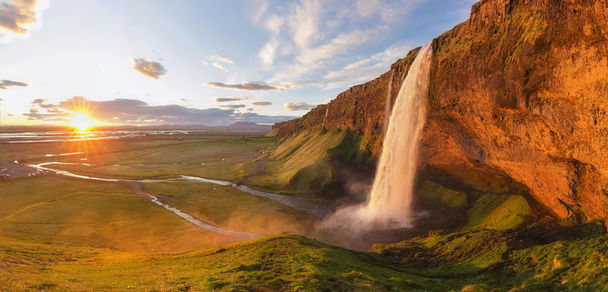Easily accessible from Reykjavik, the Golden Circle is a 300-kilometre loop linking the standout sights of southwest Iceland, offering a captivating snapshot of the country’s breathtaking natural wonders. You’ll discover majestic waterfalls, erupting geysers, moss-covered lava fields and so much more. While Thingvellir National Park, Geysir Geothermal Area and Gullfoss waterfall are the three most renowned attractions along the Golden Circle route, this guide will introduce you to some of the region’s lesser-known gems as well.

Thingvellir National Park
Around a 45-minute drive from Reykjavik, Thingvellir National Park is the first stop on the Golden Circle route when driving clockwise. As the meeting point of the North American and Eurasian tectonic plates, thousands of years of geological activity has formed a colossal rift valley, speckled with rivers, waterfalls and Iceland’s largest lake, Lake Thingvallavatn. You can trace for yourself the seismic activity by walking along the rift valley or even snorkelling or scuba diving between two continents in the crystal-clear water of the Silfra fissure.

Thingvellir National Park in autumn
But, there’s more to Thingvellir than its remarkable geography; it’s also a place of significant cultural importance, as recognised by its UNESCO World Heritage status. The world’s first democratic parliament, the Alþingi, was founded here in 930 AD, and continued to meet in this location until 1798. Fragments of around 50 booths built from turf and stone can still be seen today.

Silfra fissure
Geysir Geothermal Area
The Geysir Geothermal Area, which sits in the Haukadalur Valley, contains a plethora of hot springs, geysers, fumaroles and belching mud pots. The original Geysir after which the area is named is actually in a period of relative dormancy, with only two eruptions recorded this century (in 2000 and 2016).

Strokkur geyser
Nearby Strokkur, however, reliably erupts every 5-10 minutes, shooting a jet of boiling water around 15-20 metres into the air. It’s a spectacular sight and undoubtedly one of the highlights of the Golden Circle – so be sure to have your camera at the ready. Just across the road, there’s a well-equipped visitor centre with a restaurant and a souvenir store.
Gullfoss
Translating directly as the Golden Falls, Gullfoss is arguably Iceland’s best-loved waterfall. Fed by the Hvítá River, its two-tier cascade plunges a total of 32 metres into a wide, rocky canyon. On sunny days, it’s common for its giant kickback of misty spray to play host to every colour in light’s visual spectrum as rainbows form directly over the waterfall. In winter, Gullfoss often freezes and the surrounding landscape is dusted in snow and ice, completing a truly epic scene.

Gullfoss in winter
As with Thingvellir National Park and Geysir Geothermal Area, Gullfoss has its own visitor centre. Not far from Gullfoss lies Langjökull, Iceland’s second-largest glacier, where it’s possible to join a thrilling snowmobile tour.
Secret Lagoon

Secret Lagoon, Iceland's oldest geothermal pool
Locally known as Gamla Laugin, the Secret Lagoon is Iceland’s oldest geothermal pool, dating back to 1891. The mineral rich water here is fed by natural hot springs, with a consistent temperature of between 38-40°C – perfect for a relaxing and rejuvenating soak. It’s a much more low key, stripped-back experience compared to the likes of the Blue Lagoon and Sky Lagoon, with simple, well-maintained facilities and a small cafe on-site. This is a wonderful spot to break up your Golden Circle exploration for an authentic Icelandic bathing experience. You’ll find it in the village of Flúðir, a 30-minute drive south of Gullfoss.
Kerid Crater

Kerid Crater
It might not be one of the ‘big three’ attractions on the Golden Circle route, but Kerid crater is certainly worth checking out while you’re exploring the region. This rust-red volcanic crater formed around 6,500 years ago as the product of a collapsed cone volcano, and it’s now filled with an emerald-green lake. You can hike around the rim of the crater, following an easy 1.5-kilometre loop that takes around 15-20 minutes to complete.
Laugarvatn Fontana

Jetty on Lake Laugarvatn
Around half-way between Thingvellir National Park and Geysir Geothermal Area you’ll find Laugarvatn Fontana, a geothermal spa complex beautifully situated on the shore of Lake Laugarvatn. It features several hot pools of varying temperatures, as well as traditional steam rooms, a Finnish sauna and a small wooden pier from which you can take a cold plunge in the lake itself.
Laugarvatn Fontana is also renowned for its geothermal bakery, baking fresh rye bread underground using natural geothermal heat. You can book a tour to watch this fascinating process first-hand before trying the bread served with Icelandic butter.
Selfoss

The new town centre of Selfoss, South Iceland
On the banks of the River Ölfusá, Selfoss is the largest town in South Iceland, close to the famous sights of both the Golden Circle and the South Coast. It offers plenty of accommodation, shops and restaurants, making it an excellent overnight base or a worthwhile pitstop while passing through. In 2021, its brand new town centre was completed, with 35 historic buildings reconstructed to form a vibrant cultural and commercial hub, featuring a fabulous food hall inside a renovated dairy factory and a museum dedicated to skyr, the popular Icelandic dairy product.
Hveragerði

Reykjadalur Hot Spring Thermal River
Hveragerði is typically the final stop on the Golden Circle route before returning to Reykjavik, if driving in a clockwise direction (or indeed, the first stop when following the Ring Road towards the South Coast). The town sits in a highly geothermally active area where boiling water runs just beneath the Earth’s surface. A three-kilometre hike out of town through a grassy valley will bring you to the Reykjadalur Hot Spring Thermal River, where you can take a warm dip in the river itself.
The town’s natural geothermal heat has even been harnessed to grow all kinds of fruits and vegetables in greenhouses – something that’s otherwise extremely difficult in Iceland’s harsh climate.







